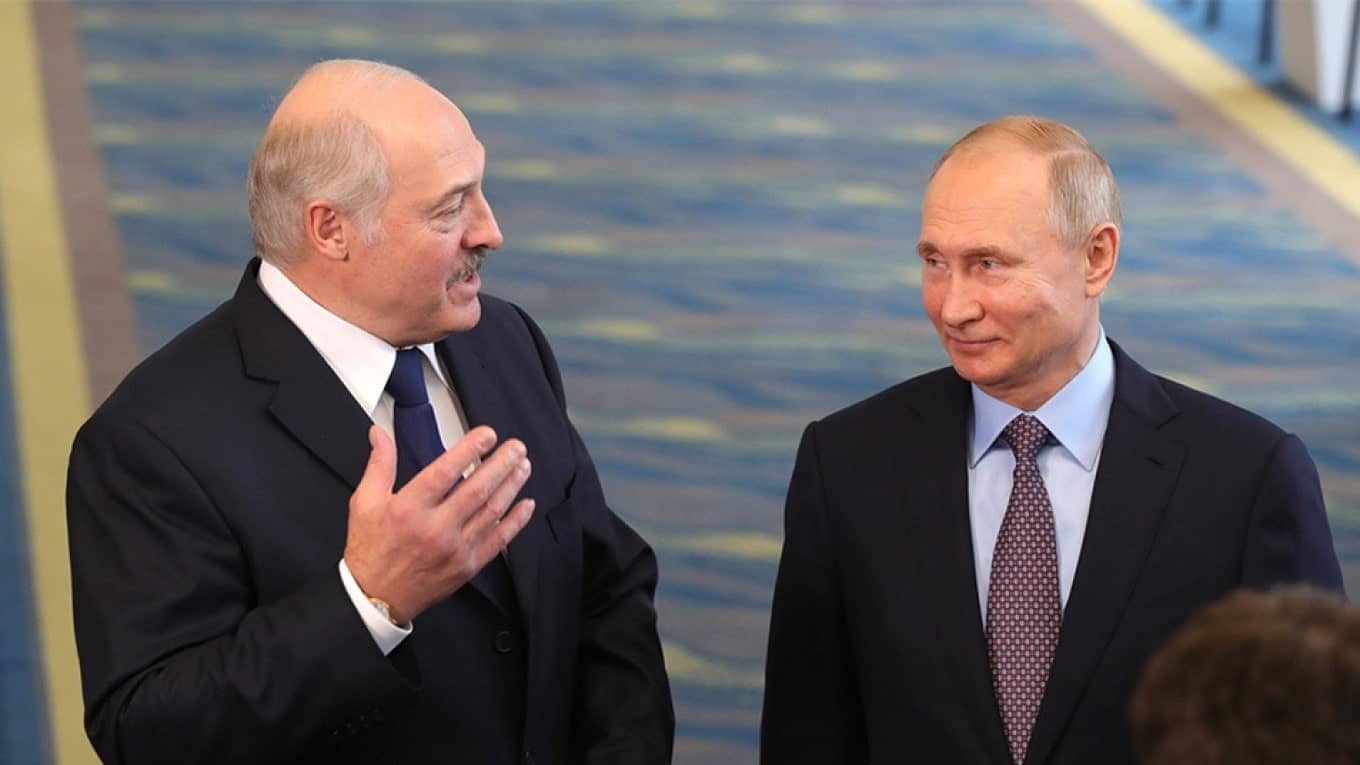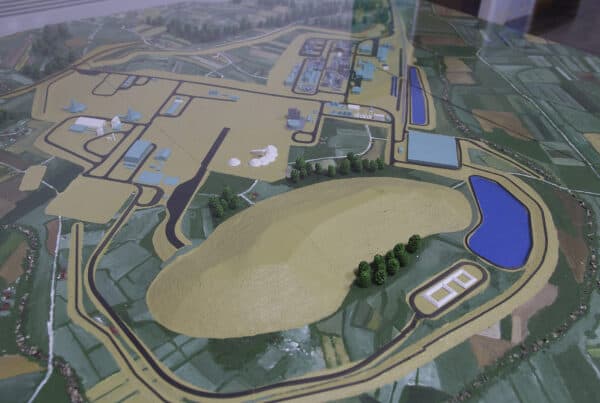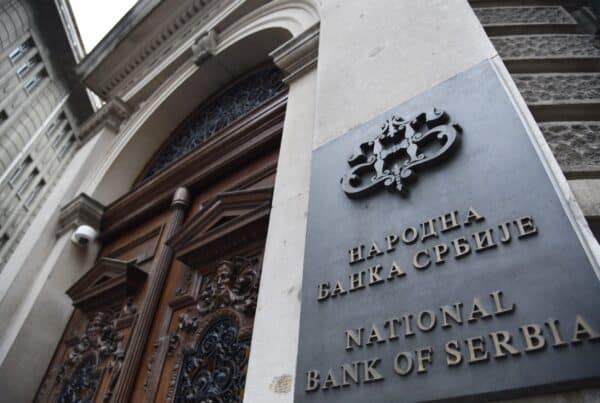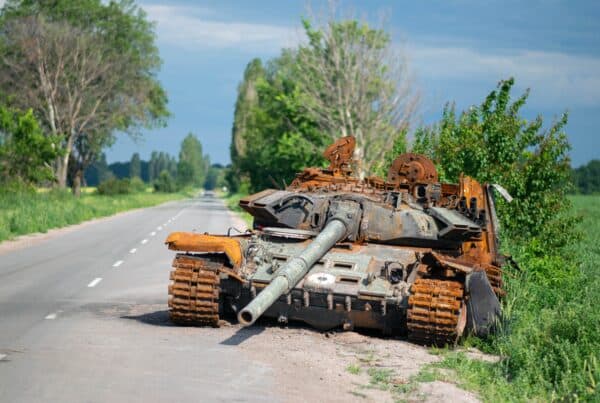An article of a Belarussian source. Fact checking by B.F.G. Fabrègue.
The question everybody may ask about the Belarus crisis is self evident . Is this crisis a “colored revolution” i.e. a foreign organised action toward destabilisation of the government? The answer is quite simple and clear : Yes… but it doesn’t matter. There is organic support for reform, and yet Lukashenko will keep the power. Here we dive into the deep trends of the crisis.

The political legitimacy of Lukashenko.
Lukashenko’s legitimacy is based primarily on his ability to maintain economic and social stability in Belarus. As such, the social contract has been damaged through his attacks on the unemployed and non-response to the coronavirus economic crisis. On the one hand, this damage will be difficult to repair, especially given Lukashenko’s stubborn personality. When you add the structural weaknesses in the Belarusian economy and constant disputes with Russia to the equation, the situation is more likely to get worse than better.
On the other hand, the economy is not collapsing and elite support for Lukashenko is showing only slight cracks. Belarus has a very cozy PPP GDP, which doesn’t translate in nominal GDP do to lack of integration, but allowing living standards similar to Russia and higher than some Central European countries. Structural factors generally favor Lukashenko. Those include Lukashenko’s control over most of the economy, weak opposition parties, low likelihood of outside support for regime change, and a loyal security apparatus that has shown a willingness to repress the population.
The situation is not hopeless for the opposition, however. Belarus lacks a real ruling party in the vein of United Russia or a coherent ideology. It lacks the kind of natural resources that might be used to maintain the loyalty of the elite in the event of growing economic or social problems. And it’s failing to provide sufficient economic growth for maintaining a pliant middle class, ad it did for the last 20 years.
Lukashenko rose to power in the post-Soviet era as defender of the Soviet model. This was very successful for a time as the country sustained consistent economic growth while resisting much of the tremendous suffering that ravaged the former Soviet states, including Russia, through the 1990’s. While Russia lost one third of its GDP, Belarus kept growing. Belarus even curtailed the financial crisis in Europe in 2008 thanks to its planned economy, but the model has since stalled out with wage growth stagnating and no marked increase in the standard of living for the average Belarusian.
This stalling out is now indicative of the Lukashenko government; stalling out domestically and in foreign affairs, for example by botching the coronavirus economic response and engaging in risky diplomatic endeavors. Belarusian political life is coming down due to internal fractures : as Lukashenko originally followed the Soviet path in some desirable ways, he has repeated the mistakes of the past by failing to uplift a new generation of leaders, clinging to solitary power, refusing to adapt and alienating the population – especially the youth – both politically and economically.
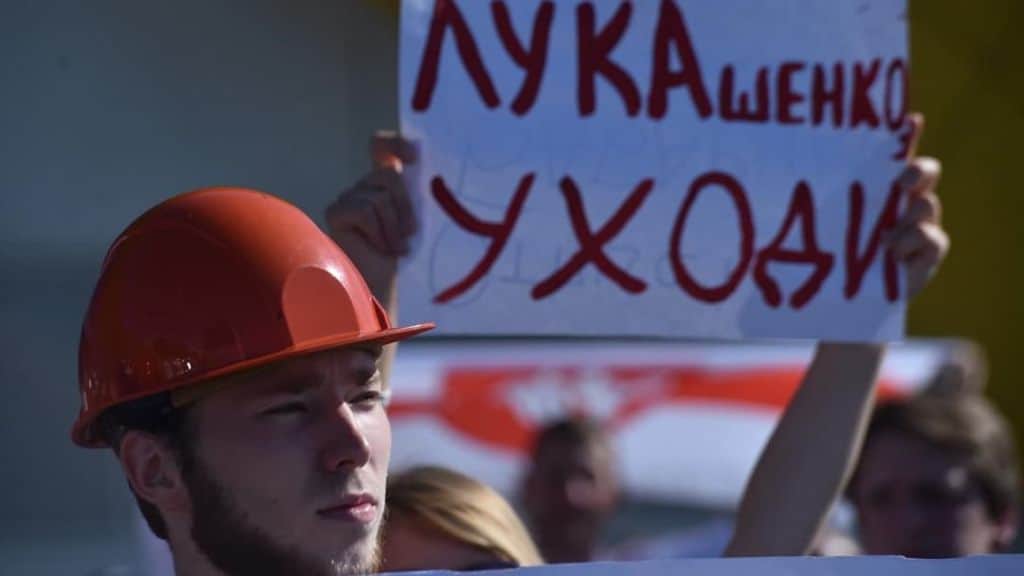
A real and widespread support for reform
Caught in the path between Russia and Germany, the Belarusian people have suffered tremendously through their history, translating into a generally cynical attitude towards politics and world affairs. In general, Belarus people are more concerned about their economic evolution than the government structuring, but give a general support for change.
A very interesting analysis can be attributed to Belarussian pro protests centrist activist Aleksey Dziermant, a member of the Belarus Academy of Sciences. On recent posts on his Facebook page, Mr. Dziermant said:
What is happening today in Belarus reminds me of the defunct USSR, it was not in vain that we were considered as a restructuring way. So that is where the movements for change came about, for democratisation and publicity. It was a broad coalition of various forces. The fronts of the people happened. For example, in the Baltic region, there were many Russians who later began to support the idea of independence. They wanted to become a bridge between Europe and Russia. But in these movements there was always a cohesive nationalist core, which then came to power. After that, Russians became non-citizens and second-class people. Also now with demonstrations in Belarus. There is the same core, and the workers and ordinary people will not be in business anymore and will bite each other’s elbows after a while. But Lukashenko isn’t Gorbachev.
Demonstrations are flourishing, but also relaxing oh how early. It is even more impossible to return to the former good state. And there are many mistakes that need to be corrected.
Changes are necessary, but as part of the change of the political system by the constitutional update, the subsequent elections. The potential for protest goes nowhere, but it must be given a means through legal forms of political struggle. That means strengthening the parties and the parliament.
The pro-Western core in the protests and for future changes is well mobilized. Even too much so. Therefore the balance between the union and the pro-Russian side is necessary.
Mr. Dziermant and the head of semi-independent Belarus Union of Journalist Andrey Krivosheyev, both openly critical of Lukashenko have both underlined how the reforms will not pass through the pressure of street protests. Both are very critical, as most of the population, of the economic conditions.
Tens of thousands of young Belarusians who are IT workers, engineers, data analysts and others in in-demand fields have been leaving the country not due to war or conflict, but because of an endemic lack of opportunity that is plaguing the country. No matter where you are in the world, no matter what political system a state has, no matter the level of democratic freedoms, this kind of situation translates to general frustration and is the source of much of the animosity surrounding this election and its aftershock. The Polish government, for instance, has just allocated 11M just for Belarus citizen visa issuance in the future.
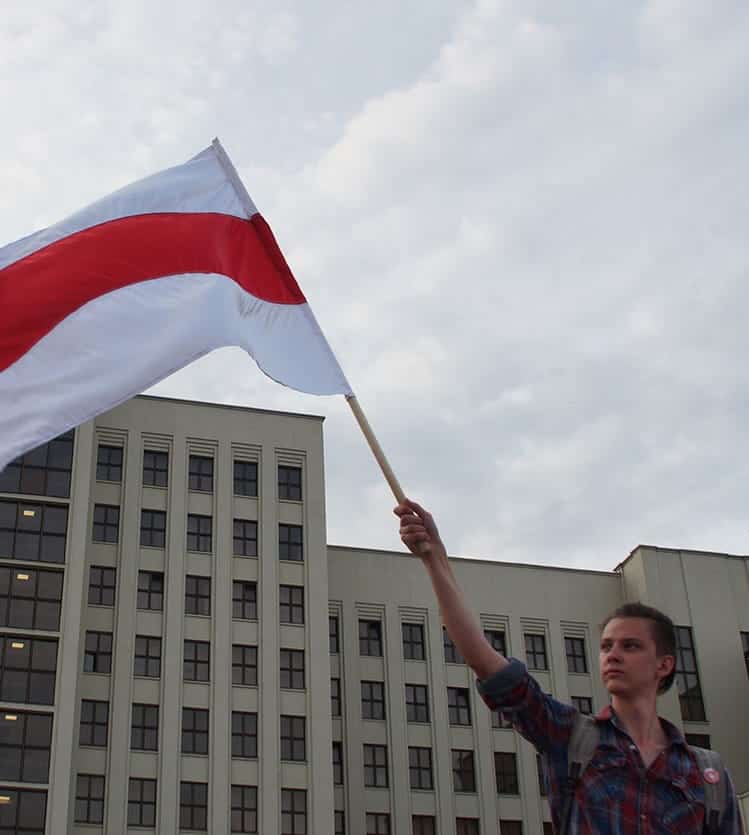
The colored revolution without partisans
While there is widespread support for reforms among Belarus people, we cannot say the same for the actual protests. Only 100’000 people gathered in Minsk, according to Western Media and Russian media which confirms the estimate as somewhat accurate or lightly inflated. Given that Minsk populations if of around 2 million people, this gives at best 1 out of 20 people protesting : this isn’t enough to force anyone out of power and considerably decrease the real strength of the movement. One observer cheered when some 200 staff of the MTZ Minsk Tractor Works staged a short walkout. But MTZ Minsk Tractor Works has 17,000 employees.
This lack of support can be however very easily linked to the “colored revolution” character of the street protests, to be opposed to the general opposition to the authoritarian power of Lukashenko. This has disgusted most of the original protestors (including both aforementioned Dziermant and Krivosheyev).
It is undeniable that a colored revolution is being staged, without success, in Belarus. Funding from American freedom structures can be found without much difficulty. Another clear example can be found among the figures chosen to represent the average protestor. For instance, one of the most consensual figures,the journalist Svetlana Alexievich, is literally not mentioned in the local media most of the time. This is weird, as Mr. Alexievich is a very prominent international figure : in the past she received both the Open Society Prize and the Nobel Prize, which makes her a very logical forefront figure. Other few lead figures that were in the first line of the revolution have shown to have literally no organic support. For instance, Maria Kolesnikova, a LGBT activist has been set on stage in during last week demonstrations, exactly as also LGBT activist Valentin Tishko was highlighted in a few Belarus feed . As there is no organic support for those issues in any Central and Eastern Europe countries,* any public figure which would endorse any measure towards LGBT rights would be excluded from any protest. Lastly, the colored character of the street protests fools no one : the former UK Minister for Europe and UK representative to the council of Europe, Denis McShane, has openly called out some form of western intervention. Quote : “Belarus needs a self-limiting revolution, not any loud-mouthed demagogy from false friends in the West.”
The reason why there is no organic support for any colored revolution, as it was underlined by 2006 (and yet still relevant) paper, can be traced back to a lot of causes.
First, unlike what some media may say, Lukashenko has a deep-rooted support, which allows him to stay in power. The direct active support for Lukashenko was estimated by the Belarusian academy of science, to be at least 24%: while this may seem very little, most countries in the EU are ruled by coalitions with similar support. In Italy, the current PD + M5S coalition barely collects 35% of popular support, mainly in the center south; former French president François Hollande collected, at his worst, only 15% of support among french population. It is , as today, very difficult to assess the exact Belarus population support for Lukashenko : it can be more or less estimated. For instance, in the 2016 election, where the foreign observers were given full access to the ballot – and described some but not massive fraud – only one member of Parliament that wasn’t part of the governing Lukasheko coalition was elected.
Second, all the protests have no organic support because they are mostly anti-Russian : and there is no anti-Russian sentiment in the country. As we explained in the first part of our explanation, unlike Ukraine, Belarussians are fond of Russia.
Third and foremost, removing Lukashenko through protests would require a strong civil society. Lukashenko has been successful in stifling civil society growth. As such, there is little to no chance for the colored revolution to succeed.
We have other facts highlighting foreign involvement. Benjamin Norton, affiliated with the journal The Grayzone, has shown how the main american administrations openly admitted working toward a colored revolution (16). Australian based journalist Caitlin Johnson has also underlined the exact facts showing how this revolution can be linked to a “colored revolution” attempt.
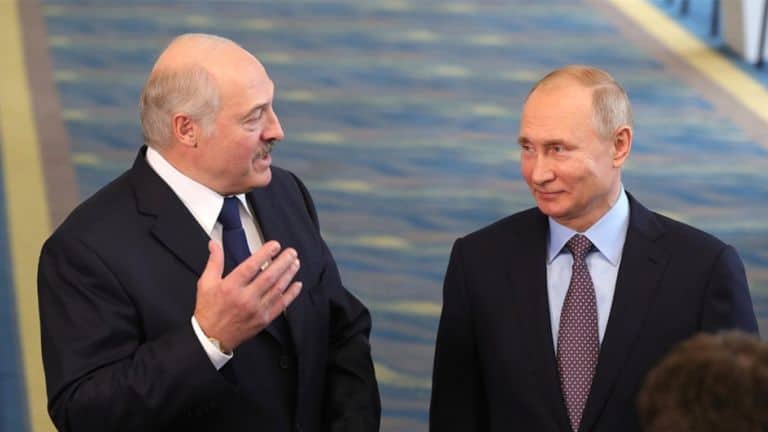
Lukashenko and Putin have been working together for more than 20 years.
The Russian double winning game.
There is outside the people, outside the street protests, and outside the general demand for reform, one clear winner : Russia.
“We saw them – they showed themselves even clearer this night. We recorded, as you know, as a former agent, calls from abroad. From Poland, the United Kingdom, and the Czech Republic, they were controlling our, excuse me, sheep: they don’t understand what they are doing, and they are already being controlled,” Lukashenko said on the 14th about the protests, also claiming that Russian and Ukrainian citizens came to the country to protest. While mostly lacking substance, since there is a real and extensive support for reform, those sentences indicate a change in Lukashenko political stance toward the West.
As we explained in part one of this analysis, Putin is set on unifying Belarus and Russia, according to the 1999 deal. At the end of the last year Putin pressed him again to finally execute the deal. When Lukashenko rejected that Putin shut off the country’s economic lifeline from Russia, including oil. Lukashenko then tried to cozy up with the Western powers, including buying U.S. fracking oil. U.S. Secretary of State Mike Pompeo came to Minsk. In March the U.S. reopened its embassy in Belarus, with an ambassador named for the first time for over 2 decades.
But now the ‘west’ Lukashenko had tried to integrate turned against him. As he was the target of an ongoing U.S. led regime change operation, and with economic pressure in direct sight, Lukashenko obviously needed help.
The initial lack of support of the Kremlin was also very evocative. While Putin was intervening on the field because of geopolitical risks, Russia international news channel, RT, allowed for open criticism of Lukashenko.
On the 15th, Lukashenko finally made up his mind and capitulated to Moscow on the Union State issue. It did not take long for Putin to respond. The Kremlin published on the 15th, in late afternoon, a note about a Telephone conversation with President of Belarus Alexander Lukashenko (emphasis added, Google translation modified by speaker):
Vladimir Putin had a telephone conversation with President of the Republic of Belarus Alexander Lukashenko at the initiative of the Belarusian side.
Alexander Lukashenko informed Vladimir Putin about the developments following the presidential election in Belarus. Both sides expressed confidence that all existing problems will be settled soon. The main thing is to prevent destructive forces from using these problems to cause damage to mutually beneficial relations of the two countries within the Union State.
In connection with the return to Russia of 32 people who were previously detained in Belarus, a positive assessment was given to close cooperation of the relevant agencies in this regard.
They also agreed on further regular contacts at various levels, and reaffirmed their commitment to strengthening allied relations, which fully meets the core interests of the fraternal nations of Russia and Belarus.
This announcement tells NATO that its over:
Lukashenko reveals details of phone call with Putin: “We have an agreement with Russia on collective security…and we agreed: if we request it, comprehensive assistance to ensure security in #Belarus will be provided to us.” Steve Rosenberg @BBCSteveR –
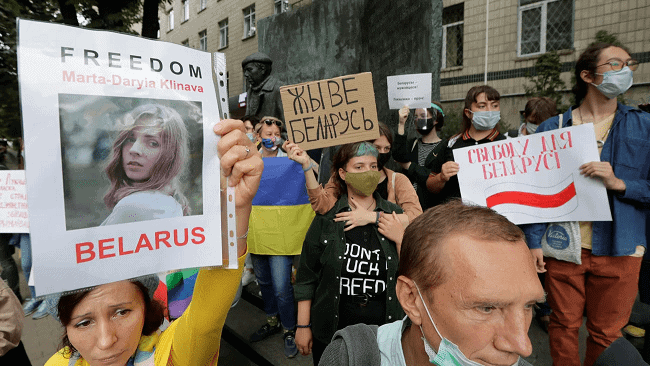
Putin accepted the deal : Lukashenko, and his police, will not hang from a pole. Russia will take care of the problem and the Union State will finally be established. Everybody has noticed this trap, such as Lithuanian Minister Linas Linkevicius, who said on Tuesday the 10th that Russia was trying to use a political crisis in Belarus to draw Minsk closer into its orbit by pressuring it to agree to closer integration. Putin is hardly invested in relations with Lukashenko, the man, as he is interested in Belarus the nation : the choice being offered to Lukashenko is very clear.
It should also be noted that the main opposition itself has no position of decoupling from Russia and isn’t being offered anything any Russia competitor. As such, Putin gathers the support of most Belarus population that doesn’t want to integrate the West, collapsing into oblivion any colored revolution support. While diminishing in the last few years, support for Union with Russia still gathers an overall majority among Belarus voters.
That does not mean that the color revolution attempt is over :but with the full backing from Russia assured, Lukashenko can take the necessary steps to end the protests.
This new situation calls however for a very important and needed analysis on the economic following for Eastern European countries.
* Reminder : Blue Europe official policy is to take no stance whatsoever, our commentary is only fact based.


